Content
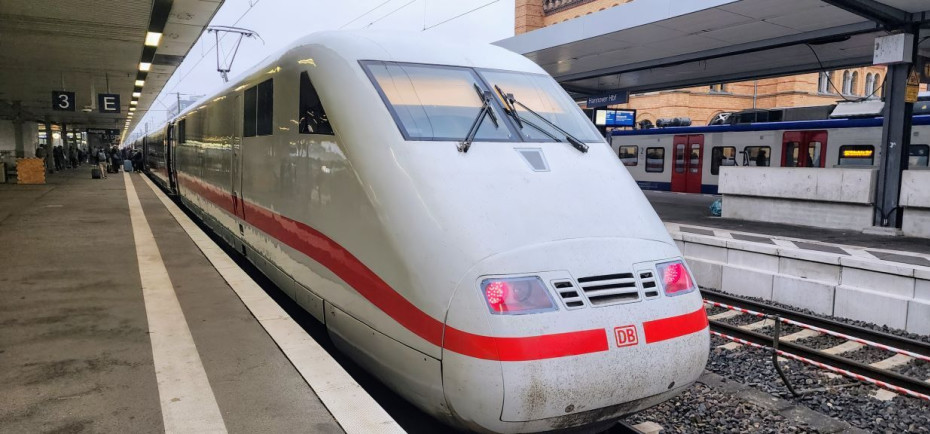
ICE 1 (Germany)
If you will be taking a journey by these ICE1 trains this guide will tell you all the key things worth knowing about the journey experience.
Share
At a Glance
Travel Pass Supplement
Rail Pass Reservation Fees
Reservations
Available
Time of Day
Day
Catering
Food services available
Restaurant
Bar (sandwiches, snacks, salads)
Accessibility
Accessing the train
Wheelchair Spaces
Train Specification
Attributes of the train
High Speed (partial journey)
Has a Conductor
Country
Which country these trains operate in.
Germany
Switzerland
Travel Passes
Eurail
Interrail
On Board
1 (1.klasse)
Perks
WiFi
A complimentary WiFi portal is available throughout this train.
Power Socket
The power sockets on this train are compatible with standard E.U. two point plugs.
Trolley Service:
A catering trolley with hot and cold drinks and snacks should be taken through the train at some point during its journey.
2 (2.klasse)
Perks
WiFi
A complimentary WiFi portal is available throughout this train.
Power Socket
The power sockets on this train are compatible with standard E.U. two point plugs.
Good to know info
ShowMeTheJourney has anticipated what questions are most often asked about travelling on these ICE-2 trains managed by the German national rail operator, DB.
If you can't find the information you are seeking, you can ask a question and the AI enabled service will try to write an answer, telling you what you wish to know.
How fast does the train travel?
These trains travel typically travel at up to 280 km/h (175 mph) when on the high speed lines and up to 200 km/h (125 mph) on other routes.
The high speed lines which these trains use are:
- Hannover ↔ Wurzburg
- Leipizg ↔ Nurnberg
- Ingolstadt ↔ Nurnberg
- Mannheim ↔ Stuttgart
- Karlsruhe ↔ Offenburg
Are seats allocated when booking tickets?
Reservations on these trains are now only automatically included when booking Flexpreis Plus tickets for 1st and 2nd class travel - these are the most expensive types of ticket sold by DB.
When booking any other type of ticket reservations can be added for an additional fee.
Can specific seats be selected from a seating plan?
Yes, this is typically available when both opting to reserve and in the scenarios when seats are automatically assigned.
If your preferences include seats at tables or seats in Quiet zones, you will need to use the seating plan.
Do Eurail / InterRail users need to make reservations?
They are available, but optional for journeys by these ICE-2 trains.
What catering is available on the train?
All of these ICE-2 trains have a bar/bistro service and a restaurant service is also available.
A non-complimentary at-seat catering service of the full menu is available in First class.
Is Wi-Fi available?
Yes - it is available free-of-charge in both 1st and 2nd class.
Are power sockets available?
Yes and the sockets are compatible with standard EU plugs.
Is a Quiet Coach available?
These trains have 'Quiet zones' in both 1st and 2nd class, though to ensure your seats(s) are either located within or outside of the areas on the train in which mobile calls are permitted, it's best to opt to reserve and then use the seating plan.
What is the luggage policy?
In addition to hand luggage, one additional larger piece of luggage or item can be taken on board of charge, provided this load can be carried by one person alone.
The luggage racks on the train have been designed to handle a maximum item size of 700 x 500 x 300 mm (height x width x depth).
Are wheelchair spaces available?
Yes and they are located at one end of a 2nd class coach, closest to the mobility accessible toile
Can non-folding bicycles be taken on board?
Not on this type of ICE train.
Can dogs be taken on board?
Small dogs which can be placed in pet-carriers can be taken on board any train as hand luggage and there is no charge for doing so.
Dogs which can't be fitted in carrier/container, because they are larger than a typical domestic cat, require tickets,
So when booking online for a journey by ICE or IC trains with DB, the German national rail operator, add a larger dog as 'a passenger'.
The price charged will be 50% of the adult rate
If you want to travel 1st class you will need a 1st class ticket for the dog.
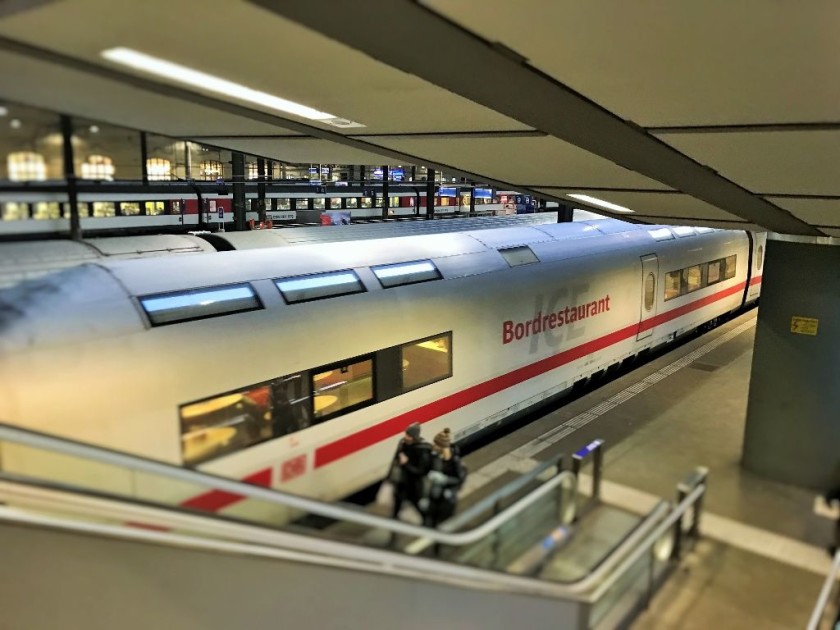
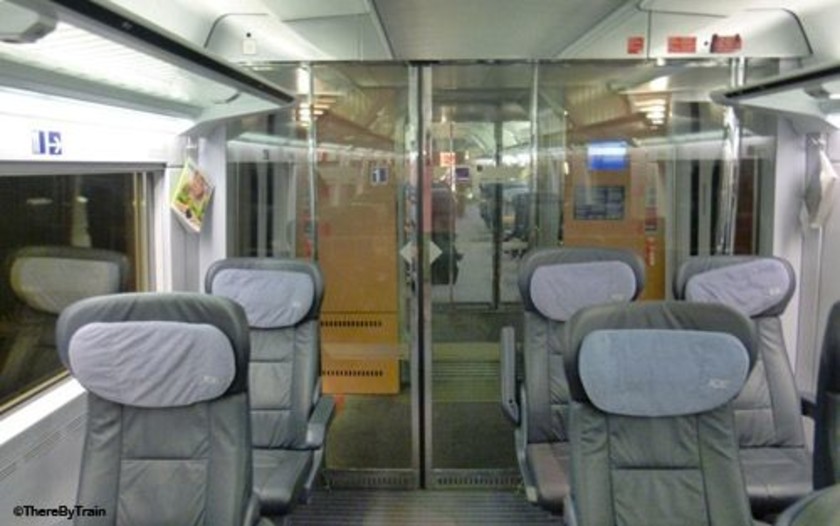
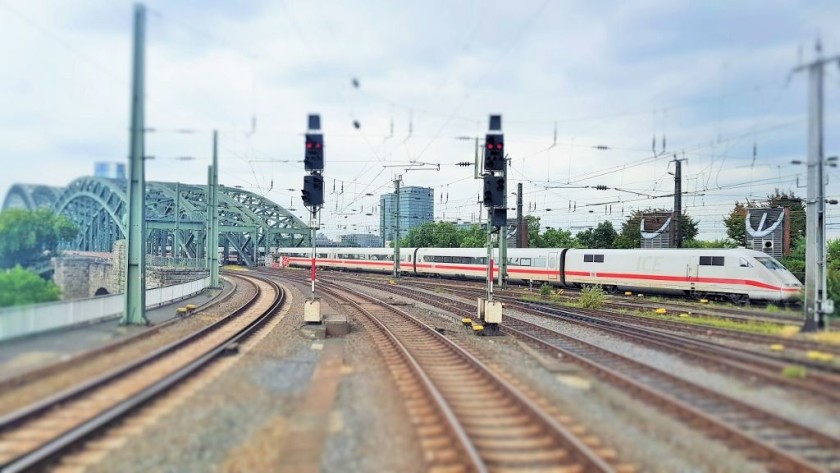
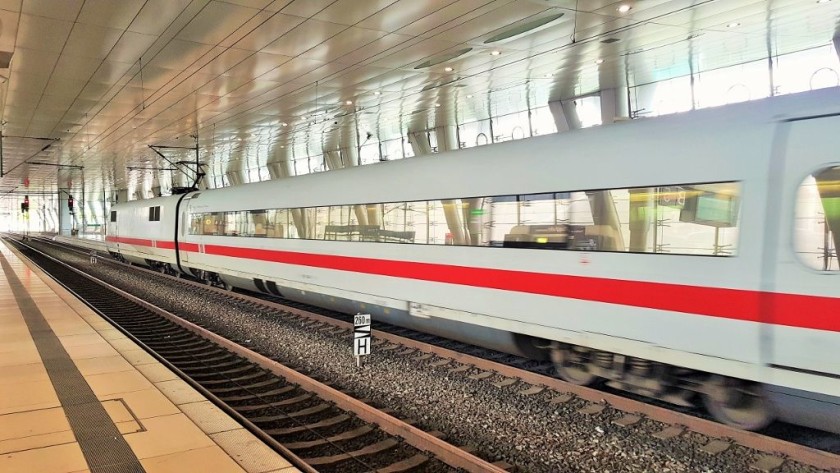
ICE 1 travel guide:
These trains are the first generation of ICE (Inter City Express) trains, and they travel up to 280 km/h on some of the high speed lines in Germany.
These trains may be up to 25 years old, but it generally doesn’t show, in recent years they have been refurbished so that they enable travellers to charge their phones etc, but on many routes these ICE 1 trains are being superseded by the brand new ICE 4 trains, so they're being switched to routes that used to be catered for by IC trains.
Routes:
If you take an ICE train on these three routes, you will almost be certainly travelling on an ICE-1 train:
(1) Berlin - Kassel - Frankfurt Flughagen/Airport
(2) north of Koln - Koln - Koblenz - Mainz - Mannheim - Heidelberg - Stuttgart (the non-high speed ICE route).
(3) Frankfurt (Main) - Berlin Spandau - Berlin Hbf - Berlin Ost (Sprinter service)
(4) Koln - Berlin Spandau - Berlin Hbf - Berlin Ost (Sprinter service)
These ICE 1 trains are also used on most of the departures on these routes:
Frankfurt (Main) - Berlin Sudkreuz - Berlin Hbf - Berlin Gesundbrunnen (Sprinter service)
Tickets and Reservations:
Reservations are now only automatically included when upgrading Flexpreis tickets to 1st class, or when booking Flexpreis Plus tickets for 1st and 2nd class travel.
When purchasing the cheaper Super Sparpreis and Sparpreis tickets for journeys by express train, you can opt to either:
- travel 2nd class and add a seat reservation for an additional fee of €5.20.
- book 1st class / upgrade a 2nd class ticket to 1st class and add a seat reservation for an additional fee of €6.50.
When booking Flexpreis tickets for travel in 2nd class, you can add a seat reservation for an additional fee of €5.20.
If your journey involves more than one ICE train, you will only have to pay one reservation fee, as it will cover all the trains you will be taking.
It is also possible to book reservations at a later date separately from the ticket booking, both online or by using DB branded ticket machines at stations.
Although if you do book your reservations later and your journey involves more than one train, you will then have to pay for separate reservations per train.
Select specific seats
When you opt to reserve, or automatically assigned reservations when booking 1st class Flexpreis tickets/ Flexpreis Plus tickets, DB tends to assign seats randomly.
So if you want your seats to be:
- by a window or on the aisle
- adjacent to a luggage rack
- in a compartment
- in a Quiet Zone; 1st class in coach 12; 2nd class in coach 2 (and in coach 4 on the 12 car trains)
- at a table
you can select any seats which are still available on the seating plan
Note that facilities such as compartments and Quiet Zones may be in an entirely different coach / carriage to that in which the seats you have been initially assigned are located.
All ICE trains have family compartments and / or family areas in 2nd class, but when making a booking for a party of adults + children, if you opt to add a reservation, you won't automatically be assigned seats in these family areas.
So you will need to find and select them (when still available) on the seating plan.
But ICE 1 trains have either 9 cars or 12 cars; on the 9 car trains the family compartment is in coach 6 and the family area is in coach 5
On the 12 car trains the larger family compartment is in coach 9, but there are also family compartments in coach 5.
Boarding:
ICE-1 trains are always at least 12 coaches long, so using all the information on the gleis/platform/track, which will tell you on which zone to board each carriage/coach, is recommended.
Some coaches/carriages only have one door, while others have two.
A number ‘1’ by the doors indicates that the coach is 1st class, while a ‘2’ indicates second class.
These numbers are the only indication of whether a coach is 1st class and vice versa and they can be hard to spot on a fast arriving train.
There is also nothing on the exterior of ICE1 trains to indicate their destination and calling points, so avoid assuming you are boarding the correct train, always confirm the destination on the gleis/platform/track info screens.
The doors won’t open automatically, so you may have to press the green button to the right of the door.
If you have NOT reserved seats, a less obvious aspect of travelling by ICE 1 trains is that they have 'Quiet' and 'Phone' zones'
So look out for the signs on the exterior and interior of the trains indicating whether a particular coach has these zones.
You can then either target or avoid seats in these areas.
Four things worth knowing about seat reservations when boarding:
(1) Reservations are indicated by electronic red text next to seat numbers that show the stations, between which the seat has been reserved.
So if, for example, you board a Hamburg – Munchen train at Hamburg Hbf and see Hamburg – Munchen by a seat number, then this seat will be occupied for the entire journey.
However other seats may only be reserved between Wurzburg and Munich, so if you’re travelling from Hamburg to Wurzburg, you can sit in this seat.
(2) Seat numbers that have no text beside them, are available for all or the remainder of the journey.
(3) You may see 'ggf. freigeben' displayed which indicates that a seat MAY be free, but avoid if possible, as in our experience it usually means that the seat WON'T be free for the entire journey.
(4) An unusual feature is that the red text by the seat number, turns itself off 15 mins after the train has departed from the station from which the seat is reserved.
The logic being, is that that if the holder of the reservation doesn’t claim the seat, then passengers without reservations who board at the next station will know that the seat is available.
So if you do have a reservation and are travelling alone, take care to not be absent from your seat when the train calls at stations.
On board summary:
The power sockets are only available at table seats and not at the airline style seats.
An unusual feature of these trains is that some seats are arranged into compartments with a door to the corridor in both 1st and 2nd class, while others in both classes are in open plan seating saloons.
If you haven't reserved, check whether you happen to be sitting in a 'Quiet Zone', if you are the conductor, or your fellow travellers, will ask you not to make or receive calls during your journey.
Using the WiFi:
These trains have WiFi access - but data usage can be more restricted in 2nd class.
On international services you may to have log in again to access the WiFi when the train crosses a border.
When available you can access D-Bahn’s WiFi network without having to register and it is free to use.
Catering:
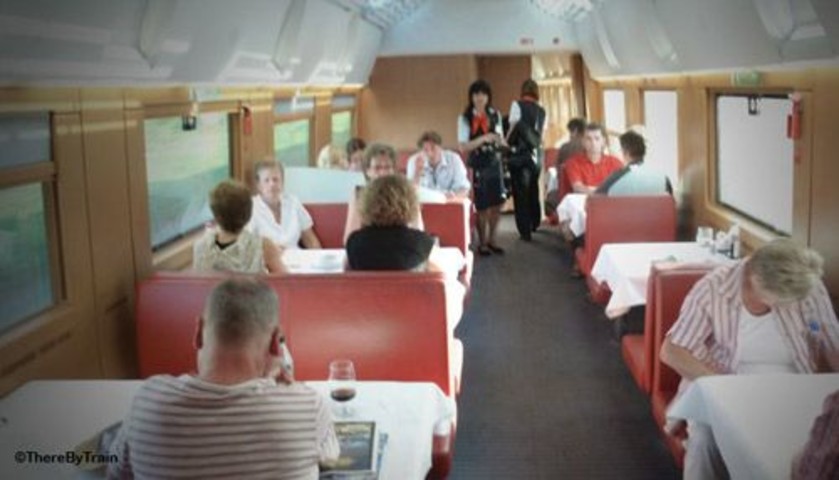
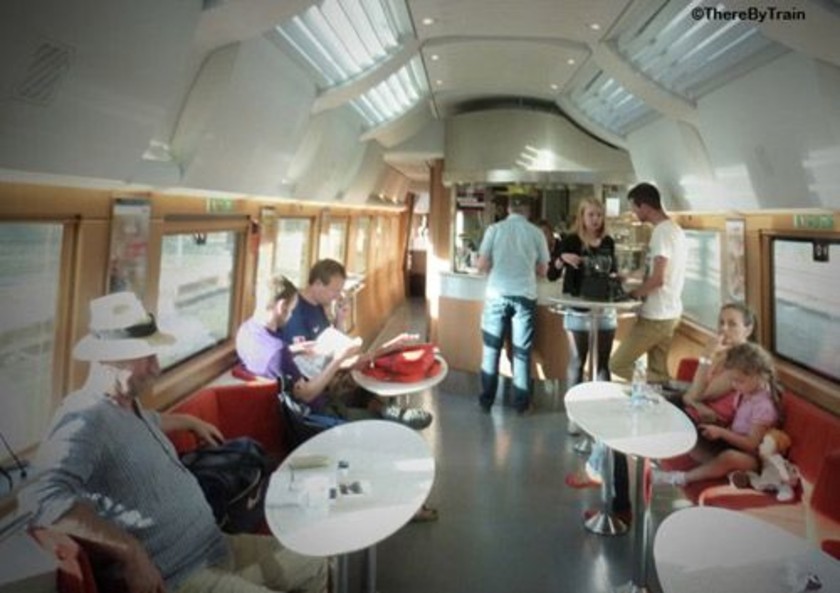
These trains have a restaurant car at which you can take a seat at a table and order food to be brought to you, irrespective of whether you will be travelling 1st or 2nd class.
The prices aren't exceptionally expensive, but the food is quality home-style rather than fine-dining.
You can either join the restaurant car for part of the journey, or head straight to it when you board.
Though you won't be allowed to linger in your seat(s) once you have finished your meal.
There is no trolley catering on ICE trains.
Travelling 1st class:
An attendant will also pass through 1st class taking orders for food and drink to be delivered to your seat – try to avoid confusing them with the conductor who will check the tickets etc.
Be aware that you will be charged for all items that you order at your seat.
If you’re travelling 1st class and are particularly thirsty/hungry, don’t wait for the catering attendant to make their round, go to the bar counter and order in person.
Worth knowing:
On ICE trains glasses and china plates and cups are used and not paper and plastic.
Very classy and probably more eco-friendly too, but take care!
It is not unknown for items to fly off tables when brakes are applied or when trains take corners at high speed.
This second version of ShowMeTheJourney is exciting and new, so we are genuinely thrilled that you are here and reading this, but we also need your help.
We’re striving not to let anything get in the way of providing the most useful service possible, hence a facility has been set up with DonorBox which can be used to support the running costs and make improvements.
Instead of advertising or paywalls, your financial support will make a positive difference to delivering an enhanced service, as there’s a lot of ideas which we want to make happen.
So if you have found the info provided here to be useful, please consider saying thank you.

This is one of more than 100 train travel guides available on ShowMeTheJourney, which will make it easier to take the train journeys you want or need to make. As always, all images were captured on trips taken by ShowMeTheJourney.



